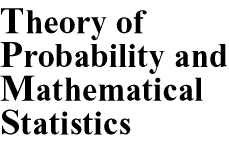Threshold structure of optimal stopping strategies for American type option. II
Authors:
H. Jönsson, A. G. Kukush and D. S. Silvestrov
Journal:
Theor. Probability and Math. Statist. 72 (2006), 47-58
MSC (2000):
Primary 91B28, 62P05; Secondary 60J25, 60J20
DOI:
https://doi.org/10.1090/S0094-9000-06-00663-6
Published electronically:
August 10, 2006
MathSciNet review:
2168135
Full-text PDF Free Access
Abstract |
References |
Similar Articles |
Additional Information
Abstract: The paper presents results of theoretical studies of optimal stopping domains of American type options in discrete time. Sufficient conditions on the payoff functions and the price process for the optimal stopping domains to have one-threshold structure are given. We consider monotone, convex and inhomogeneous-in-time payoff functions. The underlying asset’s price is modelled by an inhomogeneous discrete time Markov process.
References
- M. V. Rubtsov, A boundary layer under the impact of planar jets with low viscosity, Dinamika Sploshn. Sredy 51 Mekh. Bystroprotekayushch. Protsessov (1981), 108–128, 192–193 (Russian). MR 664664
- J. Jacka, Optimal stopping and the American put, Mathematical Finance 1 (1991), 1–14.
- H. Jönsson, A. G. Kukush, and D. S. Silvestrov, Threshold structure of optimal stopping domains for American type options, Proceedings of the Conference Dedicated to the 90th Anniversary of Boris Vladimirovich Gnedenko (Kyiv, 2002), 2002, pp. 169–176. MR 2028749
- H. Jönsson, A. G. Kukush, and D. S. Silvestrov, Threshold Structure of Optimal Stopping Strategies For American Type Options, Research Report 2004-2, Department of Mathematics and Physics, Mälardalen University, 2004.
- H. Jönsson, A. G. Kukush, and D. S. Silvestrov, Threshold structure of optimal stopping strategies for American type option. I, Teor. Ĭmovīr. Mat. Stat. 71 (2004), 82–92; English transl., Theory Probab. Math. Statist. 71 (2005), 93–103. MR 2144323, DOI https://doi.org/10.1090/S0094-9000-06-00650-8
- I. J. Kim, The analytic valuation of American options, The Review of Financial Studies 3 (1990), 547–572.
- Robert C. Merton, Theory of rational option pricing, Bell J. Econom. and Management Sci. 4 (1973), 141–183. MR 496534
References
- M. Broadie and J. Detemple, American options on dividend-paying assets, Fields Institute Communications 22 (1999), 69–97. MR 664664
- J. Jacka, Optimal stopping and the American put, Mathematical Finance 1 (1991), 1–14.
- H. Jönsson, A. G. Kukush, and D. S. Silvestrov, Threshold structure of optimal stopping domains for American type options, Theory Stoch. Proc. 8(24) (2002), no. 1–2, 169–176. MR 2028749
- H. Jönsson, A. G. Kukush, and D. S. Silvestrov, Threshold Structure of Optimal Stopping Strategies For American Type Options, Research Report 2004-2, Department of Mathematics and Physics, Mälardalen University, 2004.
- H. Jönsson, A. G. Kukush, and D. S. Silvestrov, Threshold structure of optimal stopping strategies for American type option, I. Teor. Ĭmovir. Matem. Statist. 71 (2004), 82–92; English transl. in Theor. Probab. Math. Statist. 71 (2005), 93–103. MR 2144323 (2006h:91075)
- I. J. Kim, The analytic valuation of American options, The Review of Financial Studies 3 (1990), 547–572.
- R. C. Merton, Theory of rational option pricing, Bell Journal of Economics and Management Science 4 (1973), 141–183. MR 0496534 (58:15058)
Similar Articles
Retrieve articles in Theory of Probability and Mathematical Statistics
with MSC (2000):
91B28,
62P05,
60J25,
60J20
Retrieve articles in all journals
with MSC (2000):
91B28,
62P05,
60J25,
60J20
Additional Information
H. Jönsson
Affiliation:
Mälardalen University, Box 883, SE-721 23 Västerås, Sweden
Email:
henrik.jonsson@mdh.se
A. G. Kukush
Affiliation:
Kyiv University, 01033 Kyiv, Ukraine
Email:
alexander_kukush@univ.kiev.ua
D. S. Silvestrov
Affiliation:
Mälardalen University, Box 883, SE-721 23 Västerås, Sweden
Email:
dmitrii.silvestrov@mdh.se
Keywords:
Markov process,
discrete time,
American type option,
convex payoff function,
optimal stopping
Received by editor(s):
May 24, 2004
Published electronically:
August 10, 2006
Additional Notes:
Supported in part by the Visby programme (funded by the Swedish Institute), and by grants from the Knowledge Foundation and the Royal Swedish Academy of Science.
Article copyright:
© Copyright 2006
American Mathematical Society




